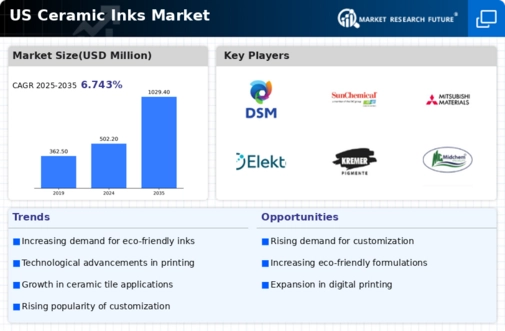The ceramic inks market is currently characterized by a dynamic competitive landscape, driven by innovation, sustainability, and technological advancements. Key players such as Mitsubishi Gas Chemical Company (US), Ferro Corporation (US), and Esmalglass-Itaca Grupo (US) are at the forefront, each adopting distinct strategies to enhance their market positioning. Mitsubishi Gas Chemical Company (US) emphasizes innovation in product development, focusing on eco-friendly formulations that align with growing environmental concerns. Meanwhile, Ferro Corporation (US) has been actively pursuing strategic partnerships to expand its product offerings and enhance its supply chain capabilities, thereby strengthening its competitive edge. Esmalglass-Itaca Grupo (US) appears to be concentrating on regional expansion, particularly in North America, to capitalize on the increasing demand for high-quality ceramic inks in various applications.
In terms of business tactics, companies are increasingly localizing manufacturing to reduce lead times and optimize supply chains. The market structure is moderately fragmented, with several players vying for market share, yet the influence of major companies remains substantial. This competitive environment fosters innovation and encourages smaller firms to differentiate themselves through niche offerings and specialized products.
In November 2025, Ferro Corporation (US) announced a strategic partnership with a leading digital printing technology firm to enhance its product capabilities. This collaboration is expected to facilitate the development of advanced ceramic inks that cater to the evolving needs of the digital printing sector, thereby positioning Ferro as a key player in this niche market. The strategic importance of this partnership lies in its potential to drive innovation and expand Ferro's market reach, particularly in the rapidly growing digital printing segment.
In October 2025, Mitsubishi Gas Chemical Company (US) launched a new line of sustainable ceramic inks designed to meet stringent environmental regulations. This initiative not only reflects the company's commitment to sustainability but also addresses the increasing consumer demand for eco-friendly products. The launch is likely to enhance Mitsubishi's reputation as a leader in sustainable practices within the ceramic inks market, potentially attracting environmentally conscious customers.
In September 2025, Esmalglass-Itaca Grupo (US) completed the acquisition of a regional competitor, which is anticipated to bolster its market presence in North America. This acquisition is strategically significant as it allows Esmalglass to leverage the existing distribution networks and customer bases of the acquired company, thereby accelerating its growth trajectory in the region. The move underscores the trend of consolidation within the market, as companies seek to enhance their competitive positioning through strategic acquisitions.
As of December 2025, the ceramic inks market is witnessing trends such as digitalization, sustainability, and the integration of AI technologies. These trends are reshaping the competitive landscape, with companies increasingly forming strategic alliances to leverage complementary strengths. The shift from price-based competition to a focus on innovation, technology, and supply chain reliability is becoming evident. Moving forward, competitive differentiation will likely hinge on the ability to innovate and adapt to changing market demands, as well as the capacity to deliver sustainable and technologically advanced solutions.
























Leave a Comment